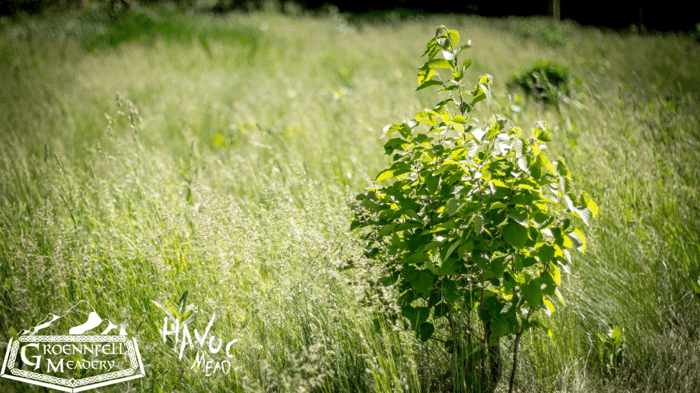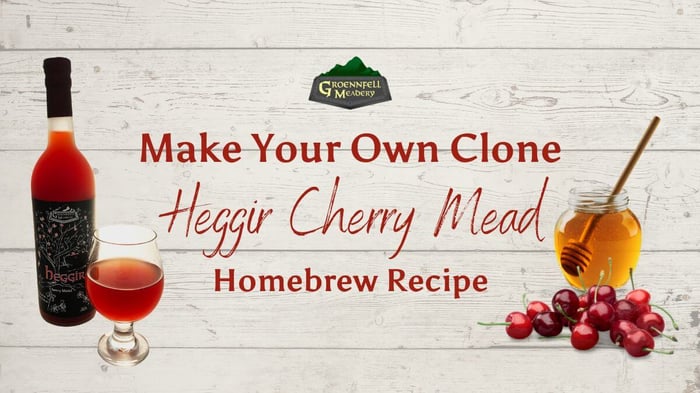Mead is, of course, made from honey.
If you’re reading this article, you almost certainly know that fact. You probably also know that the type of honey matters enormously for the final products as well as the yeast, fermentation temperature, carbonation, quality of water, and a myriad of other factors.
Then there’s terroir, the climate, microclimate, soil, microbiome, macrobiome, and other factors that influence all agricultural products. We used to focus on just the minerals in the soil when we talked about terroir (probably because that’s what was visible on early microscopes and early soil samples), but now we know that there are so many more factors that influence the taste and overall quality of a fruit.
$16.99
Nordic Farmhouse has been brewed in some form for at least 3,000 years along the coasts of the region we now call Sweden. This Craft Mead version of the Scandinavian classic is crisp and a little funky, thanks to a… read moreNordic Farmhouse Cranberry Mead by Groennfell

While grapes, apples, and cranberries happily grow on all continents (except for Antarctica, where they grow miserably), there are obviously regions of the world that excel in producing these fruits. Some varieties or varietals will dominate in one region or another, partially out of local tastes, but often due to productivity (abundance of fruit) or quality (y’know, like that one piece of land called Château Lafite Rothschild).

Then there are the things that are as particular as a southern grandmother. We’re talking vanilla and ginger, the kinds of plants that tell you to turn up the heat when it’s already 82, then tell you it’s too hot when it hits 88. “Now it’s too humid.” “Now it’s too dry! Are you actually trying to kill me, Gloria???”
Then there’s the human element, and this is all too often forgotten. Everyone knows that there is no better tomato in this world than the one you pick in your own garden. No taste test will convince someone from Médoc that a Napa Cab actually, might, just might taste better. People are fiercely defensive of their local cuisine, and right they are! Wherever you are from, we genuinely believe, your food is the best that the world has to offer. Which at last leads us to the point of this announcement…
Groennfell Meadery is officially switching to all US and Canadian-grown fruit for all of our meads.
When we started Groennfell Meadery ten years ago, the 2008 and recession was just starting to recede, and some of the most renowned fruit in the world was available in the US. We’re talking Spanish cider apples, Marasca cherry juice from the Balkans, Madagascar Bourbon Vanilla, and more!
Can you imagine how exciting this was to young meadmakers? The US dollar was so strong that we could actually afford these ingredients! And we want to say that we made some damn cool meads with these ingredients. It was a once-in-a-lifetime opportunity, and we will always be thankful.
$19.99
This is our signature Belgian-style cherry mead, brewed with European cherries at high temperatures to create a fruity, tart, full-bodied drink. We named this mead after the beings that bring those from the land of the living to the land of… read morePsychopomp Sour Cherry Mead by Havoc

Over the years, we’ve learned more and more about the fermentation process, and we often compare our early brewing selves to a 17th Century nobleman in a modern grocery store. After he polished off the fruit he recognized and maybe tried some raw meat, with all of that untouched food around him, he’d probably starve to death. In other words, we thought we were hot stuff, but it took us a decade to learn how to work with the amazing abundance that was around us, and we’re still learning every day.
As we’ve experimented and learned from other meadmakers, we’ve found ways to unlock unthought-of flavors from fruits and honeys with nothing more than yeast and time. We’ve slowly been transitioning our supply over to local production (more on what local means in a moment), but we’ve decided to draw a line in the sand and share with you just how we came to this decision.

Before we go a step further, it bears repeating: There are absolutely amazing fruits and herbs from all around this blue-green globe, and we wish we had a hundred lifetimes to brew with and eat every one of them. An apple from New York or Appalachia is not inherently better than an apple from York or Asturias.
So, here are the big reasons that we’re making this transition.
- Although there are numerous organizations that try to maintain oversight of the world supply chain, we are so committed to ethical working conditions, that we’ve found that (though they are not perfect) the US and Canadian agricultural systems allow us greater tracking of the individual farms involved in our supply chain.
- It’s difficult to measure the total energy expenditure for any specific agricultural product (Did they start in heated greenhouses? Were they mechanically or manually harvested? Was the processing facility solar powered?), but monitoring the distance of the refrigerated supply chain is something that we can get a handle on as we pursue a full Scope III analysis.
- We are absolutely committed to Feasting Culture, and feasting requires community. We are able to build one-to-one relationships with so many more farmers here in the US and Canada than we could when we were getting drums and totes from across the sea.
Before we go on to what this means, let’s talk about how we’re using the terms local and domestic and why.
Domestic is easy, that means produce from the United States. The reason that we’re going domestic for all of our fruit - beyond the three reasons listed above - is that we have access to USDA and FDA data by virtue of being US producers. It also means that when we advocate for increased minimum wage for farm workers, universal health care, and other things we believe in, we know who’s being impacted by that advocacy.
Local means folks within an easy day’s drive of us (less than eight hours), and that includes a large portion of Canada. Our meadery is less than twenty minutes from the Canadian border, and if people in Crescent City, California consider things from San Diego local, we’re talking about less than half of that distance. We have a very close relationship with several Canadian farmers, but for now we’re only going to be working with them for honey and specialty crops, not fruits.
Now that you know why we’re doing this, what does it mean for you?
The answer is, well, it depends on what you care about. As it says above, we’ve been transitioning our supply to domestic for several years now, so most of the meads won’t change much. But what this means for us is that we’ll have greater oversight of the practices and working conditions of the farms that we work with.
Even if you can’t taste the difference, we want to know that everyone who picks the fruit that goes into our mead is treated as a human being with inherent worth and dignity. We want to know that the growing practices for these crops build the soil for the next generation, rather than depleting it.

The biggest thing is that some of our favorite products, like Psychopomp, are going to be available with the flow of the season. We have already transitioned our cherry to domestic, but we’re now buying juice at the height of the season, so if you’re reading this at about the time it’s written (April 2022), you should grab your Psychopomp now before it’s gone. It won’t be back until the Michigan harvest this fall. All of our maple products will run with the sap!
As for those ingredients that come from around the world like ginger, vanilla, tea, and cardamom, we’re exploring new ways to get deeper insight into the farms that grow these culinary delights! (Unless, of course, someone wants to figure out how to breed a cold tolerant vanilla orchid! Then we’ll grow them ourselves!)
We’re so incredibly excited for all of the new relationships that we’ve been developing, and we’re so thankful for all of the farmers around the world making such amazing products! And, as a final note, we are more than happy to grab a pint of an amazing Spanish cider whenever one is available! We love local, no matter where your local is!
$19.99
Root of All Evil is back with its combination of bright lemon and spicy ginger. Fans of Root are going to love the balance on this one. Our signature ginger mead is spicy and dry, crisp and clean, warming and… read more
Root of All Evil Ginger Mead from Havoc





